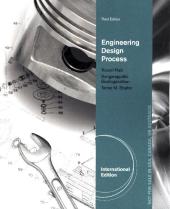 Neuerscheinungen 2017Stand: 2020-02-01 |
Schnellsuche
ISBN/Stichwort/Autor
|
Herderstraße 10
10625 Berlin
Tel.: 030 315 714 16
Fax 030 315 714 14
info@buchspektrum.de |

Yousef Haik, Tamer M. Shahin, Sangarappillai Sivaloganathan
(Beteiligte)
Engineering Design Process, International Edition
3rd ed. 2017. 320 p. 254 mm
Verlag/Jahr: CENGAGE LEARNING EMEA; CL ENGINEERING 2017
ISBN: 1-305-25330-2 (1305253302)
Neue ISBN: 978-1-305-25330-8 (9781305253308)
Preis und Lieferzeit: Bitte klicken
Gain a clear understanding of engineering design as ENGINEERING DESIGN PROCESS, 3E outlines the process into five basic stages -- requirements, product concept, solution concept, embodiment design and detailed design. Discover how these five stages can be seamlessly integrated. The book illustrates how the design methods can work together coherently, while the book´s supporting exercises and labs help you navigate the design process. The text leads the beginner designer from the basics of design with very simple tasks -- the first lab involves designing a sandwich -- all the way through more complex design needs. This approach to the design model equips you with the skills to apply engineering design concepts both to conventional engineering problems as well as other design problems.
Preface.
1. Introduction.
Chapter Objectives. Nature and Definition of Design. The Challenges of Design. Conventional Design Process. Introduction to Systematic Design. Design Process and the Design Model. Management of Design Process. Other Design Models. Structure of the Book and How to Use this Book. Chapter Summary. Problems. Lab 1: Design Model in Action -- A Tale of Developing a Sandwich. References.
PART I: GENERAL.
2. Essential Transferable Skills.
Objectives. Working in Teams. Scheduling. Research Skills. Technical Writing and Presentation. Presentation Style. Chapter Summary. Problems. Lab 2: Ice Breaking -- Forming Teams. Lab 3: Project Management (Microsoft Project). References.
3. Ethics and Moral Frameworks.
Chapter Objectives. Professionalism. NSPE Code of Ethics. Theory--Code of Ethics and Moral Frameworks. Moral Reasoning and Approaching Ethical Dilemmas. Chapter Summary. Problems. Lab 4: Ethics and Moral Frameworks. References.
PART II: REQUIREMENTS.
4. Identifying Needs and Gathering Information.
Objectives. Problem Definition: The Design Brief or Need Statement. Standards and Standardization. Human Factors. Organizing the Goal -- Objective Tree. Gathering Information: Clarifying the Need. Relevant Information Resources. Web Tools. Design Methods for Information Analysis. Market Analysis Report. Chapter Summary. Problems. References.
5. Customer Requirements.
Objectives. Customer Requirements. Choosing Customers. The Method. Eliciting the Customer Requirements. Planning to Extract Customer Requirements. Relative Importance of the Requirements. Examples. Chapter Summary. Problems. Lab 5: Kano Model Customer Needs Assessment. References.
PART III: PRODUCT CONCEPTS.
6. Establishing and Structuring Functions.
Objectives. Functions. Description of Devices in Function Domain. Definitions. =Functions for Conceptual Design. Function Tree Modeling. Function Structure Modeling Based on Flows. Reverse Engineering - Establishing the Functional Model of an Existing Product. Redesign Methodology. Chapter Summary. Problems. Lab 6: Reverse Engineering. References.
7. Specifications.
Objectives. Specifications What and Why? A Framework for Specification, Design and Testing. Customer Based Method by Ulrich and Eppinger. QFD-Based Method for Writing Specifications. Function-Based Method by DYM and Little. Theme-Based or Heuristic Method for Writing Specifications. Chapter Summary. Problems. References. PART IV: SOLUTIONS CONCEPT.
8. Conceptual Design.
A Typical Conceptual Design. Conceptual Design Using Morphological Analysis. Methods for Idea Generation. Approaches to Concept Design. Design Thinking. Developing Concepts -- Morphological Analysis Samples. Chapter Summary. Problems. References.
9. Concept Evaluation and Selection.
Objectives. Criteria for Concept Selection. Constraints. Concept Evaluation. Pugh´s Concept Evaluation Method. Decision Matrix. Example - Wheel Barrow to Transport Steel Balls. Chapter Summary. Problems. References.
PART V: EMBODIMENT DESIGN.
10. Concept Prototypes. Objectives. Prototypes - What Are They? Prototype Dimensions. Planning a Prototype Study. Example 1 - Shuttle of an Operating Table. Example 2 - Concept Prototype for Laying Out. Design for "X". Safety Considerations. Human Factors. Chapter Summary. Problems. References.
11. Embodiment Design.
Objectives. Embodiment Design. Embodiment Design Method by Dieter´s. Embodiment Design Method by Pahl and Beitz. Method by VDI. Embodiment Design Example - Wheelbarrow for Transporting Steel Balls. Chapter Summary. Problems. References.
PART VI: DETAIL DESIGN.
12. Detail Design.
Objectives. Production Drawings. Arrangement of Drawings. Technical Product Specification -- Standards. Chapter Summary. Problems. Lab 7: Geometric Dimensioning and Tolerancing. References.
13. Detailed Design - Engineering Analysis.
Objectives. Preliminary Analysis. Introduction to Finite Element Analysis. Material Selection. Cost Analysis. Outc


